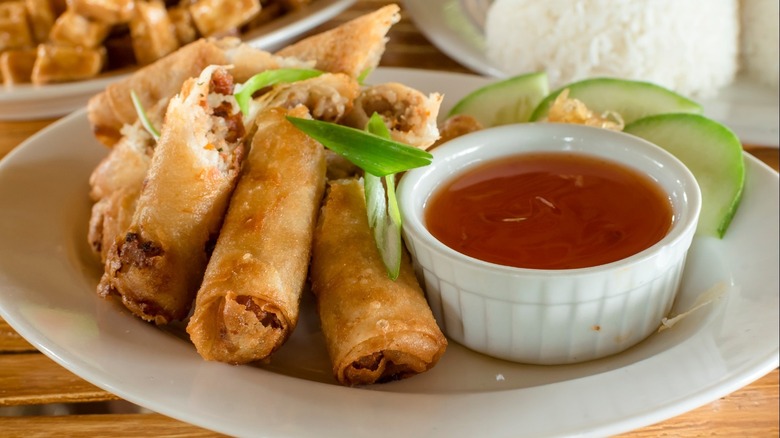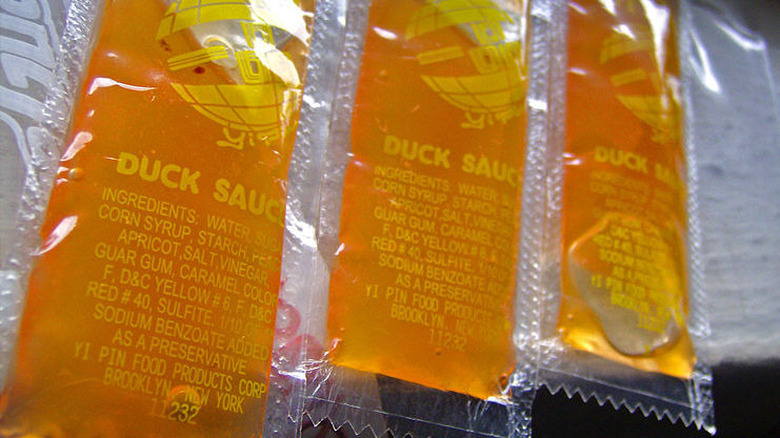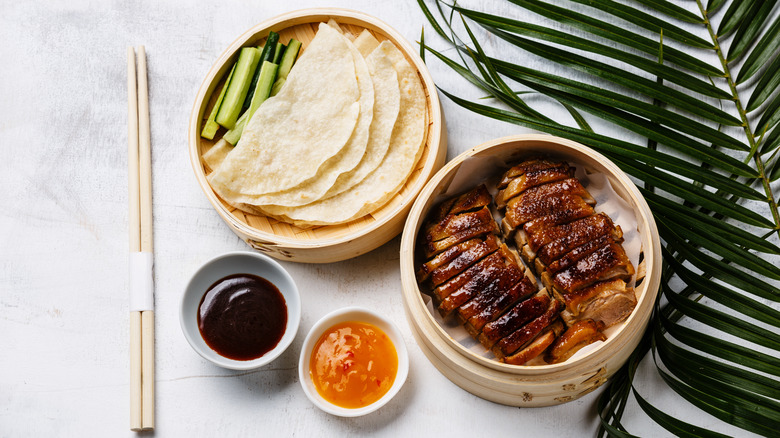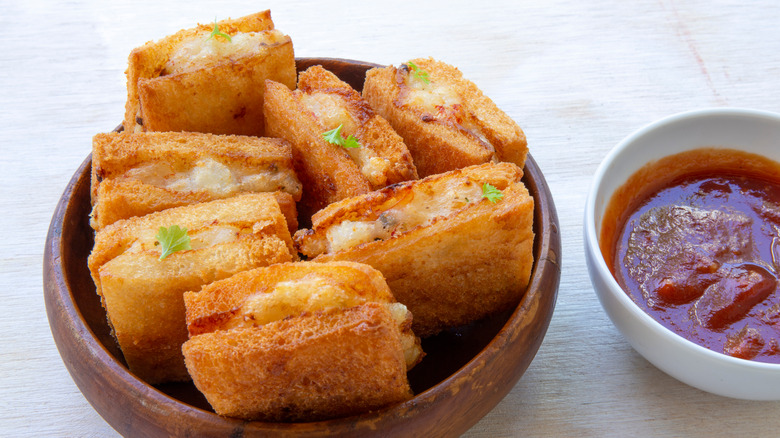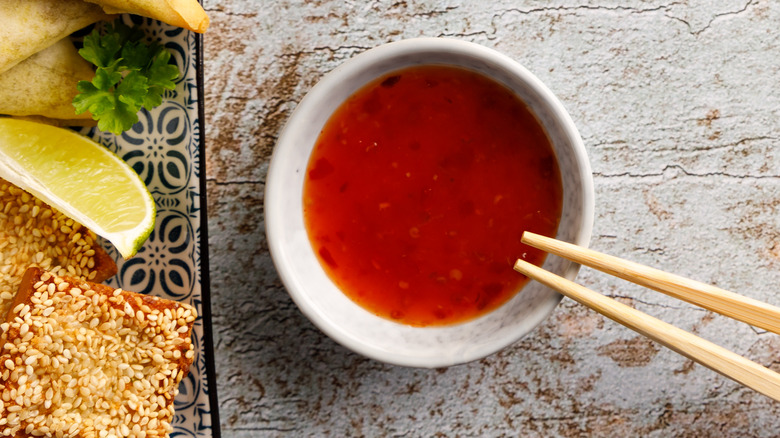What Is Duck Sauce And What Do You Eat It With?
We may receive a commission on purchases made from links.
Before anything else, we need to get one thing clear: no actual ducks are harmed in the making of duck sauce. The name of the condiment most likely came about through its association with roasted duck dishes served at many Cantonese restaurants. These are fowls roasted with an all-star cast of herbs and spices that include star anise, ginger, and spring onion (via Michelin), before they are hung up in front of restaurant windows — along with other treats like roast pork belly and Chinese barbecue pork, char siu — in a roast meat-a-palooza known as siu mei.
Duck sauce delivers the perfect balance of sweet and savory, thanks to a commingling of sugary dried fruits, tangy vinegar, and salty soy sauce. And while it might have been "originally created to balance out the richness of roasted duck and deep-fried foods," per Food Republic, duck sauce has also evolved into a common dipping sauce for a range of Chinese American dishes.
Origins of duck sauce
Unlike the sauce that likely inspired its creation, duck sauce was not born in a Chinese kitchen. Rather, the condiment is an American-born iteration, invented by Chinese immigrants who had made their way to the United States in the early- to mid-1900s. Spiceography credits unnamed researchers who say early versions of duck sauce were in fact inspired by plum sauce, since cooks had been trying to make their own versions using locally available fruits like apricots and pears. Because of its fruity roots, duck sauce is reminiscent of sweet and sour sauce, and it's the perfect condiment for deep-fried delights (like wontons and egg rolls) and meats (like spareribs, chicken, and, of course, duck).
Today minces no words about the origins of duck sauce, calling it "a very American condiment ... made with dried Turkish apricot (not a commonly used fruit in China)." Inspired by Chinese cuisine but made according to American ingredients and tastes, in short, duck sauce is about as Chinese as General Tso's chicken.
Ingredients in duck sauce
How duck sauce is made and what goes into it could well depend on where you are from because, as Smithsonian Magazine points out, different parts of the United States have different kinds of duck sauce. Chinese takeout destinations located in the Midwest or on the East Coast are more likely to pack orders of crispy noodles and fried wontons with little bags of orange dip resembling jelly, while New England diners are normally given a darker, "chunky" sauce.
We see the variances play out through different recipes found online. One recipe, shared by The Woks of Life, describes a duck sauce made with apricot preserves, pickled plum, and a dash each of soy sauce and rice vinegar, which gives you a duck sauce that is orange in color. Joy-Filled Days' recommended recipe for New England-style Chinese duck sauce calls for sweetened applesauce, apple cider vinegar, sugar, and soy sauce.
If you're wondering why there doesn't seem to be a West Coast version of duck sauce, Smithsonian Magazine reckons its because most of the duck sauce factories were established in New York and New Jersey during the 1970s, and by that time, the West Coast's opinion of what Chinese food ought (and ought not) to be would have already been set.
What to serve with duck sauce
Because duck sauce is a condiment, there are plenty of dishes you can serve it with. The Woks of Life explains that duck sauce can be used to spice up fried appetizers, like egg rolls, cream cheese wontons, shrimp toast, or fried chicken wings. It also goes well with Chinese-style barbecued spare ribs and the roast duck it's named after. Anything rich in flavor — either because it's fried in oil or contains natural fattiness or meaty flavors — is fair game with sweet, tangy duck sauce.
If your condiment drawer is full of unused packets of duck sauce, you might want to take a page out of Rachael Ray's kitchen hacks, because she them to make a shortcut sweet and sour sauce, as part of a mustard-soy dipping sauce, and even as a topping on her Peking chicken pizza. In that same vein, you could use them as an ingredient in homemade salad dressing, perhaps to accompany the fruity orange flavors found in Chinese chicken salad.
Nutritional information about duck sauce
Though both commercially made duck sauce and homemade duck sauce are prepared similarly, they may vary in nutrition facts across brand, ingredients, and other factors. If you use commercial duck sauce — which is easy to find in your Chinese takeout order, grocery store, or online at Amazon and Walmart — you're looking at about 70 calories per 38-gram serving of Roland-brand duck sauce. The same amount also has 16 grams of sugar and 300 milligrams of sodium. It's made with apricots, vinegar, and high fructose corn syrup, which is associated with health issues like high blood pressure and diabetes.
Making duck sauce at home allows you to avoid additives and high fructose corn syrup, if you wish to do so, as well as control the amount of added sugar and salt. The Woks of Life says their homemade duck sauce has 53 calories, 9 grams of sugar, and 42 grams of sodium per serving. Of course, since duck sauce is eaten sparingly as a condiment, the more significant nutritional impact comes from whatever you serve along with it.
